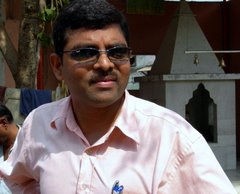a) The city of Mumbai is known as financial city of India and also has recognition at the international level. This is one of the richest metro cities and where few rich people are enjoying all sorts of luxuries and comforts. However, it is a hard fact that 55% of the population is 11 million is living in a sub-human and pitiable condition and we are deprived of basic civic amenities and facilities. Along with economical growth, migration of the people took place. On an average, there is 10% rise in terms of population in Mumbai and maximum of which try to settle
on footpaths or on the vacant place. This is bringing financial constraints to the Civic Authority and Govt. and therefore, one cannot get the solution on this. The social scientists cannot remain comfortable if the solution towards large mass is evaded for one reason or other. The city is not only for the rich but also for the poor people. They cannot deprive from the basic services. Addressing the problem of slum and that too for 60.00 lac of people with many small or big slums and dense population cannot be shelved but should be solved.
b) Dharavi experiment has given a ray of hope by way of building up people’s participation and bringing the level of confidence within the community itself. If the health and hygiene and sanitation problem of slum is not solved then many social scientists were thinking seriously that entire community is also placed under danger. A person like Subhash Dalvi had tried to find out the solution as he had better access in understanding the minds of slum dwellers. He therefore worked out novel experiment of Dattak Vasti Yojna (Adoption of slum). This philosophy of Dattak Vasti Yojna is more relevant to the preaching of Sant Gadge Maharaj who had worked for this class of people. This philosophy also is more resembling with Gandhian philosophy.
c) Through Dattak Vasti Yojna total transformation was aimed to be achieved and where rich experience of Dharavi was valuable and handy. He noticed the possibility of change. Dharavi was an experiment but Dattak Vasti Yojna is broad guidelines of policy based on this experiment.
It is a bigger module and that too for many areas. Dalvi and his team went into the different locality and convinced the people to unite themselves within the geographical boundaries and formulate a cohesive group, which can work for them. Thus the concept of Community Based
Organization (CBO) evoked. This concept was to deliver the services to the people on the principle of co-operative movement or principle of democracy. At the initial stage individual family was to contribute Rs.5/- to Rs. 7/- depending upon their need and conviction which was to be deposited in the bank.
It is a bigger module and that too for many areas. Dalvi and his team went into the different locality and convinced the people to unite themselves within the geographical boundaries and formulate a cohesive group, which can work for them. Thus the concept of Community Based
Organization (CBO) evoked. This concept was to deliver the services to the people on the principle of co-operative movement or principle of democracy. At the initial stage individual family was to contribute Rs.5/- to Rs. 7/- depending upon their need and conviction which was to be deposited in the bank.
d) The idea was that CBO will work out need of the service which is to be taken care for the benefit of the society and that of garbage removal, (Area Adoption Scheme) cleanliness, disposal of waste, water supply, cleaning of nallah etc. However, CBO will take some time build up their confidence and organizing capacity and also management of the services. To reciprocate this idea, Administration was also convinced to provide some matching
grant for procurement of material initially required and to create awareness and favourable public opinion.
e) With the series of discussions with CBO, NGO, Civic Authority, a modality was worked out wherein it was agreed that initially a population gathering of 1000 will get Rs.1200/- per month for initiation of the project during first year and this grant will be reduced next year where they will be entitled to get Rs.900/-.
f) Idea was that once this grant is available, slowly & gradually these services shall be managed by CBO through their own resources but ultimately the objective was to provide good sanitation and clean environment.
g) It is also important to mention here that most of such slums are on the Govt. or Private lands and may be illegal in status and therefore, Civic Administration cannot provide the services legitimately, which was one of the major hurdles.
h) Obviously, during this experiment the community also realized the importance of their personal health and that of their children, which need to be protected by them and for which they must work together and where CBO was most acceptable media. Today the concept of slum adoption has virtually become a major policy for the Corporation and that too with pragmatic and sincere efforts. This concept was welcomed by the Press, Politicians, mass and the social scientists. Candidly speaking, Civic Administration or the Govt. has got no alternative to accept this as a policy not only for Mumbai but for other cities all over India.
i) The broad guidelines deriving the concept are simple to be understood but needs constant efforts and persuasion to implement. Following are some of the basic advantages, which have been enjoyed by the citizens:
The garbage removal service was improved as citizens were collecting the garbage in their own premises and were required to deposit it at a pre-determined time in a bin which in turn was collected by Municipal machinery.
Flooding of Nallahs, open drain etc. was practically reduced or eliminated
The open space in the slums or around was converted into play ground for children and surrounding become cleaner and greener
Availability of water was made through CBO vis-a-vis contamination was avoided, repair was carried out in time
Question of obnoxious smell was reduced to the maximum extent ensuring clean environment
Nuisance of stray animals like dogs, cows, pigs was reduced to large extent. Because of clean environment and continuous education, health and hygiene of the citizens have been much improved which in turn brought reduction in medical bill may be to the extent of Rs. 500 – 1000
Most of the services that of cleanliness, plumbing and others were arranged through local unemployed youths and as such better job opportunity and self employment to the youths.
In many potential areas, ladies groups were involved to work with selfemployment and to promote Self-Help Group. The broad outline of Self Help Group was to work and interact with each other for better harmony, understanding and to share the responsibility.
This has provided better opportunity to work on common platform keeping away their personal differences, which normally so far have been exploited by the politicians.
This Project covers 812 Slum Pockets out of 1959 Slum Pockets in Mumbai which covers nearly 25 Lacks Populations.
Question of obnoxious smell was reduced to the maximum extent ensuring clean environment
Nuisance of stray animals like dogs, cows, pigs was reduced to large extent. Because of clean environment and continuous education, health and hygiene of the citizens have been much improved which in turn brought reduction in medical bill may be to the extent of Rs. 500 – 1000
Most of the services that of cleanliness, plumbing and others were arranged through local unemployed youths and as such better job opportunity and self employment to the youths.
In many potential areas, ladies groups were involved to work with selfemployment and to promote Self-Help Group. The broad outline of Self Help Group was to work and interact with each other for better harmony, understanding and to share the responsibility.
This has provided better opportunity to work on common platform keeping away their personal differences, which normally so far have been exploited by the politicians.
This Project covers 812 Slum Pockets out of 1959 Slum Pockets in Mumbai which covers nearly 25 Lacks Populations.
j) The Civic Administration has adopted this Dattak Vasti Yojna as its basic policy to alleviate and address the problem of citizens of lower group, which so far remained neglected. This also has provided lot of savings to the Corporation as most the Civic works and problems were being directly handled by CBO through direct participation. This has also helped in reducing the public grievances, civic complaints, which was otherwise directed to the Administration through political NGOs.
In other words, better co-ordination between local group and civic authority has been achieved. It was a Golden Handshake rather than conflict.


No comments:
Post a Comment